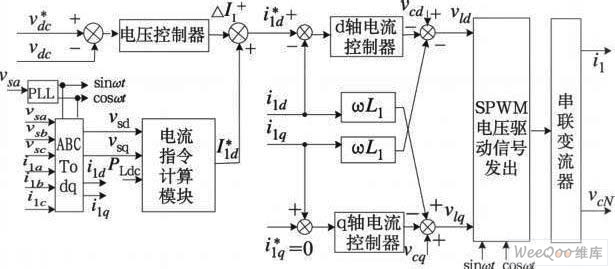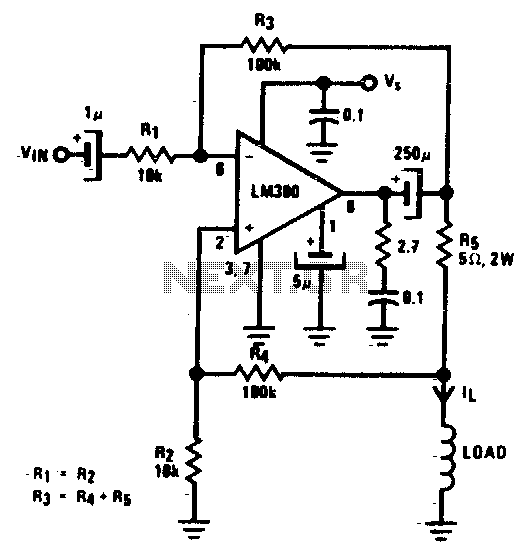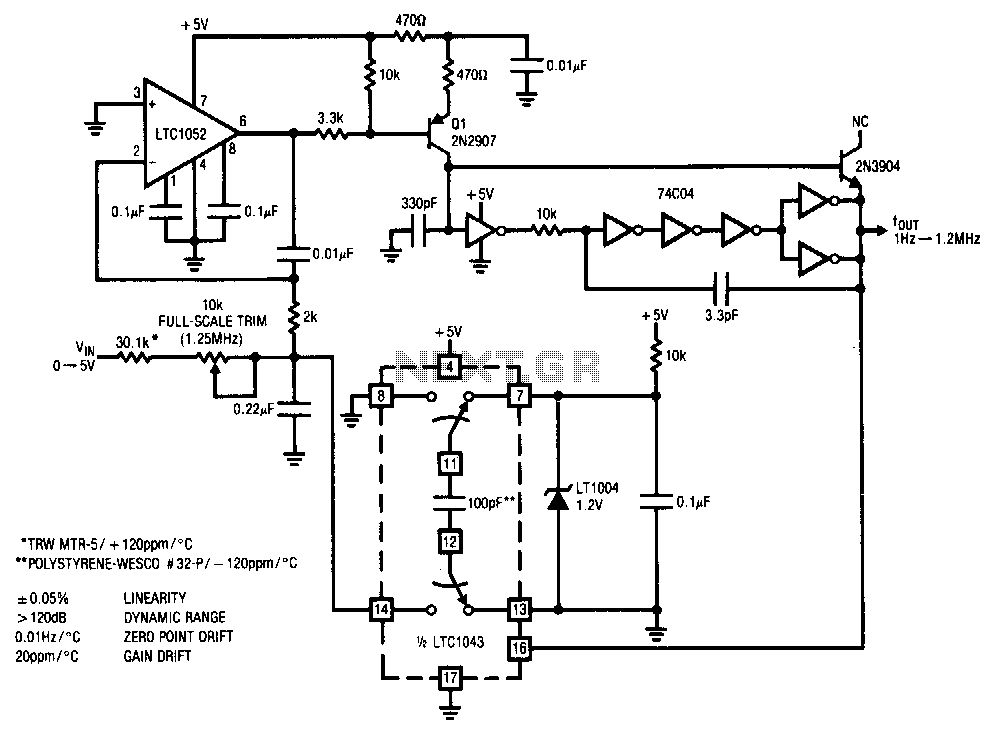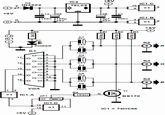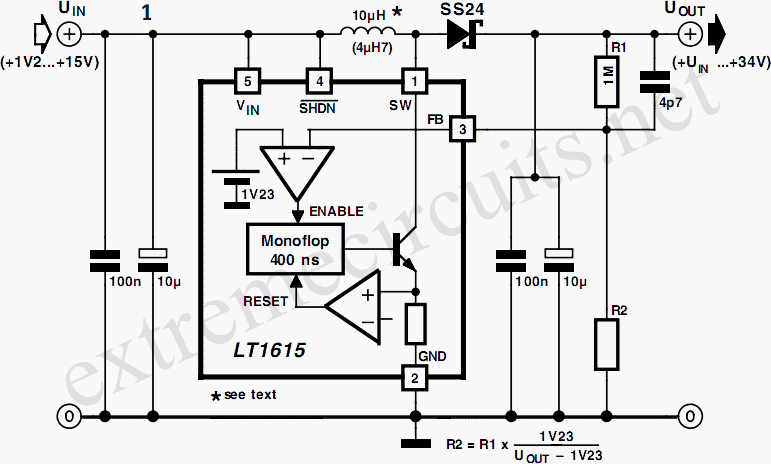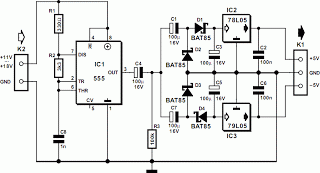
HF to LF Converter
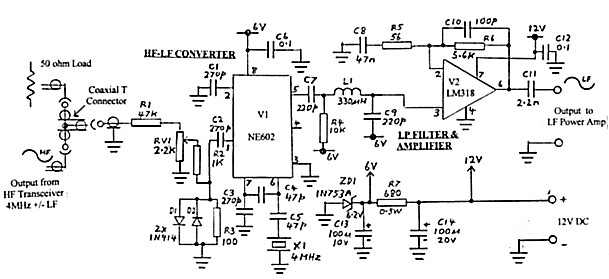
Any mode (e.g., CW, AM, SSB, FSK) initiated in the HF transmitter or transceiver can be regenerated at LF (100 to 200 kHz) using this simple converter. The LF output can drive an LF Power Amplifier. The February 2000 issue of Amateur Radio contained an article on an LF transmitter designed for CW operation, where the power amplifier was operated in a linear mode. It was only necessary to replace the VFO with an AM or sideband generator with an LF output for speech operation. A follow-up article in September 2000 discussed a Single Sideband Generator using the phasing technique, designed as a stand-alone unit for use away from the amateur station. However, a simpler arrangement could be achieved by heterodyning down from the HF output of the local HF transceiver. This article describes a circuit designed for that conversion, providing sufficient LF output level to drive the original power amplifier. The circuit diagram of the converter is shown in figure 1. The conversion occurs in V1 (type NE602), which is similar to the circuit used in an Active Loop Converter, except that the input and output frequencies are reversed. A 4 MHz crystal is used, as it is compatible with most HF amateur transceivers that tune up to 4 MHz on the 3.5 MHz band. The transceiver frequency is set to 4 MHz minus the LF transmission frequency. The overall circuit gain of V1 and V2 is arranged to operate around 20 to 30 mVPP for peak signal level to avoid distortion in the audio signal when demodulated. The power on an FT101B is reduced to around 1 watt, with the output loaded into a dummy load and attenuated through an R1-RV1-R2-R3 network. The precise drive for a given HF transmitter power is set by RV1, while diodes D1 and D2 protect V1 from excessive RF levels. To attenuate mixing products above 200 kHz, the LF output from converter V1 is fed into a low-pass network formed by L1-C9 and the feedback circuit of V2. The following LF Power Amplifier requires 6VPP at maximum swing, which V2 raises from V1 to this level. The circuit is similar to that used at the output of the SSB modulator, with the gain raised from 10 to around 70 by changing the values of R5 and C8. This arrangement achieves 6VPP with approximately 25mV of HF signal at the V1 input, with a maximum output level from V2 of 9VPP. The complete converter is powered from 12V DC, with the supply sourced from the Amplifier unit. A 6V rail is derived using a Zener diode (ZR1) and resistor (R7) to power the NE602 converter and set the operating point of amplifier V2 at half its 12V supply. The load current at 12 volts is 15mA.
The described circuit serves as a versatile converter allowing various modulation modes from HF to LF, facilitating effective communication in amateur radio applications. The use of the NE602 mixer enables efficient frequency conversion, while the inclusion of protection diodes ensures circuit integrity against excessive RF levels. The adjustable attenuation network allows for fine-tuning of the input signal, ensuring optimal performance and minimal distortion. The design's adaptability to different crystal frequencies provides flexibility in operation, accommodating various HF transceivers.
The power supply design incorporates a dual-voltage system, ensuring that the NE602 operates effectively while maintaining the necessary bias for the output amplifier. This arrangement not only simplifies the overall circuit design but also enhances reliability during operation. The gain adjustment through resistor and capacitor modifications allows for customization based on specific requirements, making the circuit suitable for a range of applications in the amateur radio domain. The inclusion of low-pass filtering further ensures that unwanted mixing products are effectively suppressed, maintaining signal clarity and fidelity in the LF output. Overall, this circuit design exemplifies a well-engineered solution for HF to LF conversion, facilitating enhanced communication capabilities for amateur radio enthusiasts.Any mode (e. g. CW, AM, SSB, FSK) which is initiated in the HF transmitter or transceiver can be regenerated at LF (100 to 200 kHz) using this simple converter. The output at LF can be used to drive an LF Power Amplifier. The February, 2000 issue of Amateur Radio (ref. 1) contained an article I had submitted on an LF transmitter. The transmitter wa s designed for CW operation but the power amplifier was operated in a linear mode and it was only a matter of replacing the VFO with some form of AM or sideband generator with an LF output to operate on speech. The article was followed up with a further article (Amateur Radio September 2000, ref 2) on a Single Sideband Generator using the phasing technique.
The design aimed at making a stand-alone unit because of the possibility of using the unit at a site away from the amateur station. However it was pointed out that a simpler arrangement might be achieved at the amateur station site by heterodyning down from the HF output of the local HF transceiver.
This third article describes a circuit designed to do that conversion and provide sufficient LF output level to drive the original power amplifier. The circuit diagram of the converter is shown in figure 1. The conversion takes place in V1 (type NE602). The V1 circuit is almost identical to that used in my Active Loop Converter (Amateur Radio July, 2000 - ref 3) except that the input and output frequencies are reversed.
I used the same 4 MHz xtal as in the receive converter as I had another one spare. Most HF amateur transceivers tune up to 4 MHz on the 3. 5 MHz band so that it is simply a matter of setting the transceiver frequency to 4 MHz minus the LF transmission frequency. (4 MHz plus LF transmission frequency could also be used if the transceiver is tuneable above the 4 MHz.
- This would make easier setting of the required HF frequency. Of course there is nothing to prevent some other crystal frequency being used with appropriate setting of the transceiver output frequency. ). The overall circuit gain of V1 and V2 is arranged so that the HF input to V1 operates around 20 to 30 mVPP for peak signal level.
This was chosen as it was anticipated that above these levels, steep increase in the level of intermodulation products could cause distortion in the audio signal when demodulated. This effect, relevant to the NE602, was discussed in one of my previous articles ( A. R. Jan 1994, ref 4). There is no point in running the HF transmitter at high output level to generate a signal. I reduced the power on an FT101B used to around 1 watt by backing off drive to the PA. The output is loaded into a dummy load and paralleled off to an attenuation network R1-RV1-R2-R3. (Note the connection via the coaxial T connector in figure 1. ). The precise amount of drive for a given HF transmitter power is set by RV1. Diodes D1 and D2 provide some protection to V1 in the event of excessive RF level. To attenuate mixing products above 200 kHz, the LF output from converter V1 is fed into a low pass network formed by L1-C9 and the feedback circuit of V2.
The following LF Power Amplifier requires 6VPP at maximum swing and stage V2 raises the output from V1 to this level. The circuit is similar to that used at the output of SSB modulator (ref 2) but the gain has been raised from the original value of 10 to around 70 by changing the values of R5 and C8 to those shown.
With this arrangement, the 6VPP is achieved with around 25mV of HF signal at V1 input. Maximum possible output level from V2 is 9VPP. The complete converter is powered from 12V DC and when operated in conjunction with the Power Amplifier (ref 1), the supply it is picked up from 12V in the Amplifier unit. A further 6V rail is derived with Zener diode ZR1 and resistor R7. This is used to power the NE602 converter, V1 and to set the operating point of amplifier V2 at half its12V operating supply.
Load current at 12 volts is 15mA. There 🔗 External reference
The described circuit serves as a versatile converter allowing various modulation modes from HF to LF, facilitating effective communication in amateur radio applications. The use of the NE602 mixer enables efficient frequency conversion, while the inclusion of protection diodes ensures circuit integrity against excessive RF levels. The adjustable attenuation network allows for fine-tuning of the input signal, ensuring optimal performance and minimal distortion. The design's adaptability to different crystal frequencies provides flexibility in operation, accommodating various HF transceivers.
The power supply design incorporates a dual-voltage system, ensuring that the NE602 operates effectively while maintaining the necessary bias for the output amplifier. This arrangement not only simplifies the overall circuit design but also enhances reliability during operation. The gain adjustment through resistor and capacitor modifications allows for customization based on specific requirements, making the circuit suitable for a range of applications in the amateur radio domain. The inclusion of low-pass filtering further ensures that unwanted mixing products are effectively suppressed, maintaining signal clarity and fidelity in the LF output. Overall, this circuit design exemplifies a well-engineered solution for HF to LF conversion, facilitating enhanced communication capabilities for amateur radio enthusiasts.Any mode (e. g. CW, AM, SSB, FSK) which is initiated in the HF transmitter or transceiver can be regenerated at LF (100 to 200 kHz) using this simple converter. The output at LF can be used to drive an LF Power Amplifier. The February, 2000 issue of Amateur Radio (ref. 1) contained an article I had submitted on an LF transmitter. The transmitter wa s designed for CW operation but the power amplifier was operated in a linear mode and it was only a matter of replacing the VFO with some form of AM or sideband generator with an LF output to operate on speech. The article was followed up with a further article (Amateur Radio September 2000, ref 2) on a Single Sideband Generator using the phasing technique.
The design aimed at making a stand-alone unit because of the possibility of using the unit at a site away from the amateur station. However it was pointed out that a simpler arrangement might be achieved at the amateur station site by heterodyning down from the HF output of the local HF transceiver.
This third article describes a circuit designed to do that conversion and provide sufficient LF output level to drive the original power amplifier. The circuit diagram of the converter is shown in figure 1. The conversion takes place in V1 (type NE602). The V1 circuit is almost identical to that used in my Active Loop Converter (Amateur Radio July, 2000 - ref 3) except that the input and output frequencies are reversed.
I used the same 4 MHz xtal as in the receive converter as I had another one spare. Most HF amateur transceivers tune up to 4 MHz on the 3. 5 MHz band so that it is simply a matter of setting the transceiver frequency to 4 MHz minus the LF transmission frequency. (4 MHz plus LF transmission frequency could also be used if the transceiver is tuneable above the 4 MHz.
- This would make easier setting of the required HF frequency. Of course there is nothing to prevent some other crystal frequency being used with appropriate setting of the transceiver output frequency. ). The overall circuit gain of V1 and V2 is arranged so that the HF input to V1 operates around 20 to 30 mVPP for peak signal level.
This was chosen as it was anticipated that above these levels, steep increase in the level of intermodulation products could cause distortion in the audio signal when demodulated. This effect, relevant to the NE602, was discussed in one of my previous articles ( A. R. Jan 1994, ref 4). There is no point in running the HF transmitter at high output level to generate a signal. I reduced the power on an FT101B used to around 1 watt by backing off drive to the PA. The output is loaded into a dummy load and paralleled off to an attenuation network R1-RV1-R2-R3. (Note the connection via the coaxial T connector in figure 1. ). The precise amount of drive for a given HF transmitter power is set by RV1. Diodes D1 and D2 provide some protection to V1 in the event of excessive RF level. To attenuate mixing products above 200 kHz, the LF output from converter V1 is fed into a low pass network formed by L1-C9 and the feedback circuit of V2.
The following LF Power Amplifier requires 6VPP at maximum swing and stage V2 raises the output from V1 to this level. The circuit is similar to that used at the output of SSB modulator (ref 2) but the gain has been raised from the original value of 10 to around 70 by changing the values of R5 and C8 to those shown.
With this arrangement, the 6VPP is achieved with around 25mV of HF signal at V1 input. Maximum possible output level from V2 is 9VPP. The complete converter is powered from 12V DC and when operated in conjunction with the Power Amplifier (ref 1), the supply it is picked up from 12V in the Amplifier unit. A further 6V rail is derived with Zener diode ZR1 and resistor R7. This is used to power the NE602 converter, V1 and to set the operating point of amplifier V2 at half its12V operating supply.
Load current at 12 volts is 15mA. There 🔗 External reference
